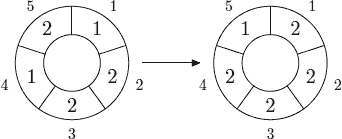题目大意:给定n(1<=n<=500)个数字和一个数字m,这n个数字组成一个环(a0,a1.....an-1)。假设对ai进行一次d-step操作,那么ai的值变为与ai的距离小于d的全部数字之和模m。求对此环进行K次d-step(K<=10000000)后这个环的数字会变为多少。
看了一篇博客:http://www.cppblog.com/varg-vikernes/archive/2011/02/08/139804.html说的非常清楚。
拿例子来说:
a矩阵:
a = 1 2 2 1 2
构造出来一个矩阵:
b =
1 1 0 0 1
1 1 1 0 0
0 1 1 1 0
0 0 1 1 1
1 0 0 1 1
(a4+a0+a1) (a0+a1+a2) (a1+a2+a3) (a2+a3+a4) (a3+a4+a0)得到的矩阵e = 5 5 5 5 4
所以题意就是:a*(b^k) = e。求出e就是通过解b^k。由于直接求b^k会超时,所以要二分求幂。
这个题的矩阵另一个性质:
利用矩阵A。B具有A[i][j]=A[i-1][j-1],B[i][j]=B[i-1][j-1](i-1<0则表示i-1+n,j-1<0则表示j-1+n)
我们能够得出矩阵C=a*b也具有这个性质
C[i][j]=sum(A[i][t]*B[t][j])=sum(A[i-1][t-1],B[t-1][j-1])=sum(A[i-1][t],B[t][j-1])=C[i-1][j-1]
“”“
所以能够求出C[0][0],以后的递推得到。
| Time Limit: 12000MS | Memory Limit: 65536K | |
| Total Submissions: 3057 | Accepted: 1232 | |
| Case Time Limit: 2000MS | ||
Description
A cellular automaton is a collection of cells on a grid of specified shape that evolves through a number of discrete time steps according to a set of rules that describe the new state of a cell based on the states of neighboring cells. The order of the cellular automaton is the number of cells it contains. Cells of the automaton of order n are numbered from 1 to n.
The order of the cell is the number of different values it may contain. Usually, values of a cell of order m are considered to be integer numbers from 0 to m − 1.
One of the most fundamental properties of a cellular automaton is the type of grid on which it is computed. In this problem we examine the special kind of cellular automaton — circular cellular automaton of order n with cells of order m. We will denote such kind of cellular automaton as n,m-automaton.
A distance between cells i and j in n,m-automaton is defined as min(|i − j|, n − |i − j|). A d-environment of a cell is the set of cells at a distance not greater than d.
On each d-step values of all cells are simultaneously replaced by new values. The new value of cell i after d-step is computed as a sum of values of cells belonging to the d-enviroment of the cell i modulo m.
The following picture shows 1-step of the 5,3-automaton.

The problem is to calculate the state of the n,m-automaton after k d-steps.
Input
The first line of the input file contains four integer numbers n, m, d, and k (1 ≤ n ≤ 500, 1 ≤ m ≤ 1 000 000, 0 ≤ d < n⁄2 , 1 ≤ k ≤ 10 000 000). The second line contains n integer numbers from 0 to m − 1 — initial values of the automaton’s cells.
Output
Output the values of the n,m-automaton’s cells after k d-steps.
Sample Input
sample input #1 5 3 1 1 1 2 2 1 2 sample input #2 5 3 1 10 1 2 2 1 2
Sample Output
sample output #1 2 2 2 2 1 sample output #2 2 0 0 2 2
#include <algorithm> #include <iostream> #include <stdlib.h> #include <string.h> #include <iomanip> #include <stdio.h> #include <string> #include <queue> #include <cmath> #include <stack> #include <map> #include <set> #define eps 1e-10 #define LL __int64 ///#define LL long long ///#define INF 0x7ffffff #define INF 0x3f3f3f3f #define PI 3.1415926535898 #define zero(x) ((fabs(x)<eps)?0:x) const int maxn = 550; using namespace std; LL e[maxn][maxn]; LL c[maxn][maxn]; LL xmul[maxn][maxn]; LL num[maxn]; LL ans[maxn]; int n, m, d; void Mul(LL a[][maxn], LL b[][maxn]) { memset(c, 0, sizeof(c)); for(int i = 0; i < n; i++) { if(!a[0][i]) continue; for(int j = 0; j < n; j++) { c[0][j] += a[0][i]*b[i][j]; c[0][j] %= m; } } for(int i = 1; i < n; i++) for(int j = 0; j < n; j++) c[i][j] = c[i-1][(j-1+n)%n]; for(int i = 0; i < n; i++) for(int j = 0; j < n; j++) b[i][j] = c[i][j]; } void expo(LL a[][maxn], int k) { if(k == 1) { for(int i = 0; i < n; i++) for(int j = 0; j < n; j++) e[i][j] = a[i][j]; return; } memset(e, 0, sizeof(e)); for(int i = 0; i < n; i++) e[i][i] = 1; while(k) { if(k&1) Mul(a, e); Mul(a, a); k /= 2; } } int main() { int k; while(cin >>n>>m>>d>>k) { for(int i = 0; i < n; i++) cin >>num[i]; memset(xmul, 0, sizeof(xmul)); xmul[0][0] = 1; for(int i = 1; i <= d; i++) xmul[0][i] = xmul[0][n-i] = 1; for(int i = 1; i < n; i++) for(int j = 0; j < n; j++) xmul[i][j] = xmul[i-1][(j-1+n)%n]; expo(xmul, k); memset(ans, 0, sizeof(ans)); for(int i = 0; i < n; i++) { for(int j = 0; j < n; j++) { ans[i] += e[i][j]*num[j]; ans[i] %= m; } } for(int i = 0; i < n-1; i++) cout<<ans[i]<<" "; cout<<ans[n-1]<<endl; } return 0; }